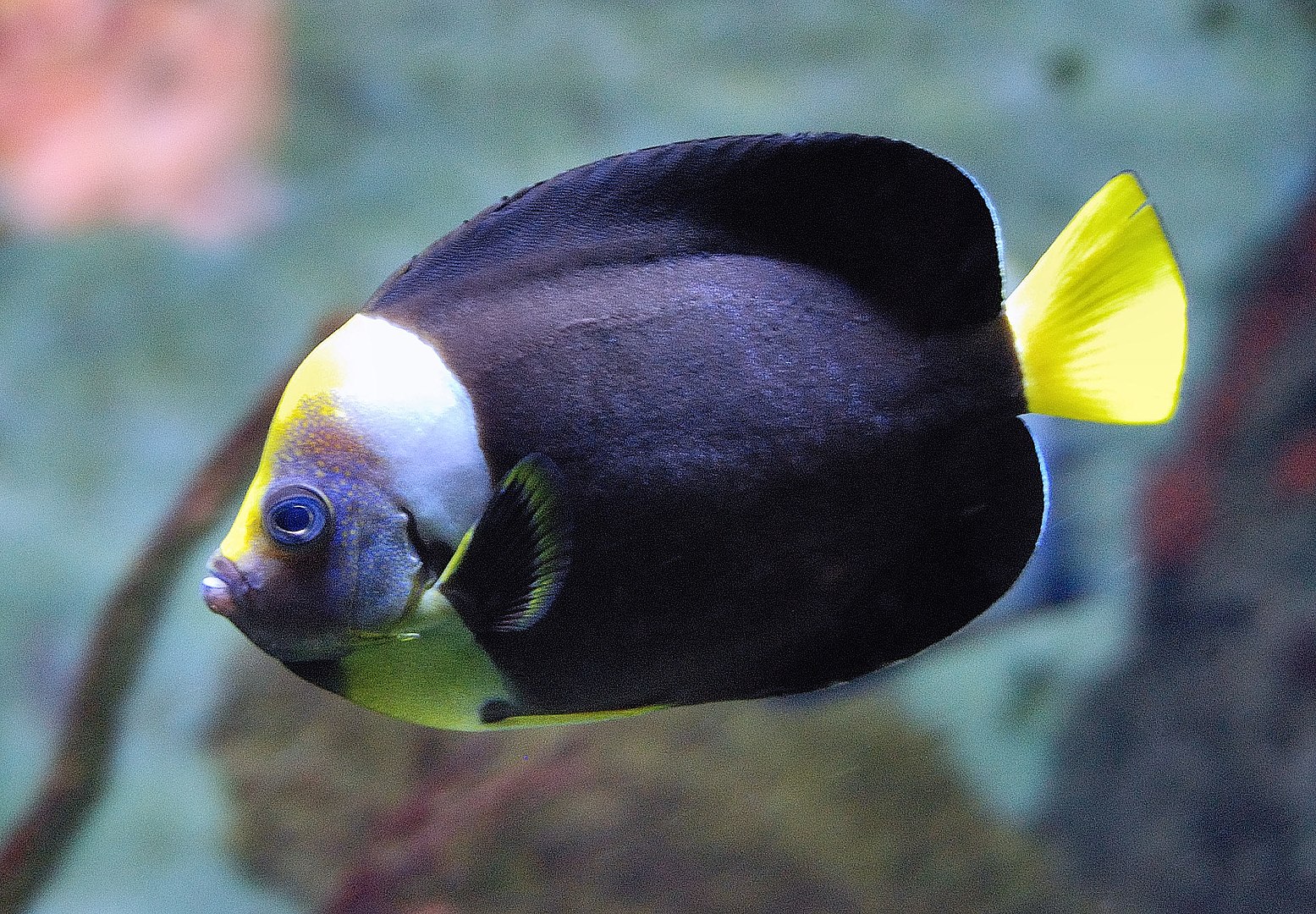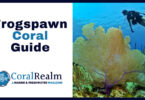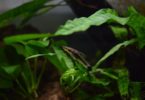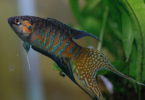Last Updated on February 10, 2023 by Matt
The Queensland Yellowtail Angelfish, Chaetodontoplus meridithii, is also known by a few other names; Meredith’s angelfish, yellow-finned angelfish, or simply the yellowtail angelfish.
This species is not commonly seen in the aquarium trade, but does make its way into home aquarium occasionally.
In this care guide, we will give a description of the Queensland Yellowtail Angelfish, its behavior and diet, compatibility, and special care that needs to be taken when housing this species.
IN THIS ARTICLE
Quick Queensland Yellowtail Angelfish Care Sheet
| Queensland Yellowtail Angelfish Summary | |
| Care Level | Intermediate |
| Family | Pomacanthidae |
| Temperament | Semi-Aggressive |
| Diet | Omnivorous |
| Origin | Australia |
| Minimum Tank Size | 185 Gallons |
| Color | Black, Blue, Yellow, White |
| Size | 9.8 inches (25 cm) |
| Reef Compatible? | No |
| Temperature | 70-79°F (21-26°C) |
| Carbonate Hardness | 8-12 dKH |
| Specific Gravity | 1.020-1.026 |
| pH Range | 8.0-8.5 |
Description and Distribution
Kingdom: Animalia
Phylum: Chordata
Class: Actinopterygii
Order: Perciformes
Family: Pomacanthidae
Genus: Chaetodontoplus
Species: meridithii
The Queensland Yellowtail Angelfish is a gorgeous fish; it has a black body with a thick white band behind the head. The head is a bluish-grey color with faint yellow spots, yellow on the forehead, and a yellow patch on the chest at the base of the head. The caudal fin is bright yellow, while the dorsal, anal, and pectoral fins are black. Pectoral fins have a yellow margin, while dorsal and anal fins have a yellowish to blue margin. The dorsal and anal fins are continuous, and run from the head to the caudal fin.
Queensland Yellowtail Angelfish reach a maximum total length of 9.8 inches, or 25 cm.
As the name suggests, they are endemic to the east coast of Australia, primarily found on the Queensland coast. They are also found as far as Sydney, and on Lord Howe Island in the Tasman Sea.
They are a member of the Chaetodontoplus genus, and the marine angelfish Pomacanthidae family. The Pomacanthidae family contains seven genera and about 86 species, which includes the Masked Angelfish, and while visually similar shouldn’t be confused with freshwater angelfish, which are cichlids of the Amazon Basin.
Behavior and Diet
The Queensland Yellowtail Angelfish is found on coastal reefs and open flats with many corals, sponges, rocks, and outcrops of sea whips.
Adults can be solitary, but are also often found in pairs and small groups. They are generally found in deeper water, up to 164 ft, and often past 98 ft. Juveniles spend their time in much shallower water hiding amongst corals and sponges. Juvenile Queensland Yellowtail Angelfish are often found under jetties.
They are protogynous hermaphrodites; there is a dominant male, and when this male dies a female will change sex and take on the male role.
They are normally relatively peaceful fish but can be aggressive towards similar species of a similar size.
Their diet consists of sponges and tunicates, and are also often seen grazing on algae. They will also nip at coral polyps, and are known to eat other invertebrates too.
In the aquarium they need to be fed a range of foods to remain healthy, such as microalgae like spirulina or nori, macroalgae such as seaweed, both small crustaceans like krill, mysis, and artemia, and larger crustaceans such as shrimp and crabs, and also sponges and tunicates. A wide range of foods is essential, especially foods which contain algae, and they need to be fed multiple times a day.
Compatibility and Tank Mates
Queensland Yellowtail Angelfish need very high water quality. As such, a good protein skimmer is needed, along with a high-quality filtration system, such as a canister filter. They also require well oxygenated water, so if the filter outflow doesn’t create enough circulation a wave maker should be used.
They need a lot of space, and a minimum tank size of 185 gallons. Water parameters aren’t much different from other tropical marine species, needing a temperature range of 70-79°F (21-26°C), a carbonate hardness of 8-12 dKH, a specific gravity of 1.020-1.026, and a pH range of 8.0-8.5. As usual, a heater and thermometer should be used to control temperature, and ensure that water chemistry is stable via regular water testing and water changes.
As they inhabit rocky and coral reef ecosystems, there should be plenty of live rock and crevices and caves for them to hide in. Especially when they have first been introduced to a new tank Queensland Yellowtail Angelfish can be very shy, hiding away until they become used to their surroundings. They will then be very lively fish, and form a territory in the tank.
While they can be aggressive towards similarly sized and similarly colored fish, Chaetodontoplus meridithii are generally peaceful fish that can be housed with many different species. They won’t eat smaller fish, and are one of the most peaceful species in the Pomacanthidae family.
Due to this, they shouldn’t be kept with other angelfish species from the same genus. However they can be kept with other species of angelfish, as long as they have enough space and their coloration isn’t similar.
Ideally they should be kept in a male-female pair, or in a group with one male and a couple of females.
However they aren’t reef safe, as they will peck at and eat sponges, tunicates, and both LPS and SPS corals, as well as nipping at clams. They will also try and eat other invertebrates such as shrimp and crabs.
Conclusion
Hopefully this quick Queensland Yellowtail Angelfish care guide has been an enjoyable read and given you the information you were looking for!
Always remember that when adding new fish to your aquarium to have your current fish well fed, and to ensure that you feed the newcomers regularly to acclimatize them quickly.
If you have any further questions then feel free to leave us a comment below!
Featured Image Photo Credit: Michael K. Oliver, CC BY-SA 4.0








